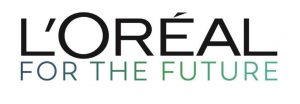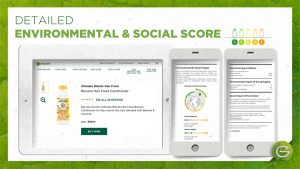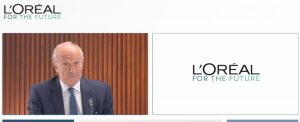 L’Oréal Group has launched a bold, ambitious sustainability program that covers the next ten years with a comprehensive blueprint of measures to meet the growing environmental and social challenges facing the world. In its “L’Oréal for the Future” program, the beauty giant says that the company is committed to “accelerating its transformation towards a model respecting planetary boundaries and reinforcing its commitments to both sustainability and inclusion.”
L’Oréal Group has launched a bold, ambitious sustainability program that covers the next ten years with a comprehensive blueprint of measures to meet the growing environmental and social challenges facing the world. In its “L’Oréal for the Future” program, the beauty giant says that the company is committed to “accelerating its transformation towards a model respecting planetary boundaries and reinforcing its commitments to both sustainability and inclusion.”
Speaking at a global digital press conference from Paris at the end of June, Jean-Paul Agon, Chairman and CEO of L’Oréal; Alexandra Palt, L’Oréal executive vice president, chief corporate responsibility officer and executive vice president of the Fondation L’Oréal; and Adrien Koskas, global brand president of Garnier, laid out the Group’s latest set of ambitions for 2030.
Transforming activities; helping solve world challenges

Alexandra Palt, L’Oréal executive vice president, chief corporate responsibility officer and executive vice president of the Fondation L’Oréal
The program has two main dimensions, 1. To transform the L’Oréal business to respect the planet’s boundaries, and 2. Contributing to solving the world’s challenges by supporting urgent social and environmental needs.
“We must transform our activities to stay within the planetary boundaries using scientific theory defining the environmental limits, and these efforts must include social inclusion,” explained Alxandra Palt, in her opening remarks.
Jean-Paul Agon, Chairman and CEO of L’Oréal, introduced the sessions, and said: “L’Oréal’s sustainable revolution is entering a new era. The challenges the planet is facing are unprecedented, and it is essential to accelerate our efforts to preserve a safe operating space for humanity. We do so in our own business operations and in our contribution to the society at large. We know that the biggest challenges remain to come and L’Oréal will stay faithful to its ambition: operate within the limits of the planet.”
To work within planetary limits, L’Oréal has committed to achieving carbon neutrality at all L’Oréal’s sites by 2025. The company will do this by improving energy efficiency and using 100% renewable energy.
In addition, 100% of the plastics used in L’Oréal’s products’ packaging will be either from recycled or bio-based sources by 2030; and L’Oréal will reduce by 50% per finished product, compared to 2016, its entire greenhouse gas emissions, also by 2030.
Three pillar-strategy
To meet these goals, L’Oréal will use a strategy built on three pillars. The first involves transforming its own business so as to respect “planetary boundaries.”
The second pillar calls for empowering its business eco-system – including customers, suppliers and its consumers – in its transformation process so that they can make sustainable consumption choices.
As part of this effort to empower its consumers to make more sustainable choices, L’Oréal has developed a Product Environmental & Social Impact Labelling mechanism, scaling from A to E, endorsed by independent scientific experts and verified by an independent auditor, which will be progressively deployed for all brands and categories.
L’Oreal says that it is also making new commitments to ensure that its suppliers’ sustainable development policies are as ambitious as its own, also for a 2030 dead-line. Palt noted that these goals include having 100% of its strategic suppliers being paid a living wage.
The third pillar focuses on contributing to solving the world’s challenges by supporting urgent social and environmental needs. To do this, L’Oréal, through an unprecedented plan launched in May 2020, is allocating €150 million to address urgent social and environmental issues.
L’Oréal says that €100 million of the investment is earmarked for key environmental challenges: €50 million will be used to finance damaged natural marine and forest ecosystems restoration projects through a fund called the L’Oréal Fund for Nature Regeneration, and another €50 million will be directed to financing projects linked to the circular economy.
Plus, to help vulnerable women, L’Oréal is also creating a €50 million charitable endowment fund to support field organizations and local charities in their efforts to fight poverty, help women achieve social and professional integration, provide emergency assistance to refugee and disabled women, prevent violence against women, and support victims.
L’Oréal: 15 years of sustainability history
L’Oréal has been pursuing sustainability goals for the past 15 years. Since 2005, the Group has reduced the carbon dioxide emissions of its plants and distribution centers by 78%, while production volume increased by 37%. At the end of 2019, L’Oréal had 35 carbon-neutral sites (meaning they use 100% renewable energy), including 14 factories.
In 2013, L’Oréal launched its Sharing Beauty with All sustainability program, which addressed the development of beauty products. Sustainability is now fully integrated into the design process of the Group’s new products, from the earliest stages, says the company. Among the results, 85% of products created or renovated in 2019 had an improved environmental and social profile. And by the end of 2019, L’Oréal has helped 90,635 people from disadvantaged communities find employment through the solidarity purchasing and inclusion programs.
New labeling, more green from Garnier
L’Oréal’s new Product Environmental & Social Impact Labelling launched in June with Garnier.
Ardrien Koskas, Garnier global brand president, announced that the brand would be launching its Green Beauty sustainable transformation initiative in July, which would be an “end-to-end approach to sustainability” that “aims to transform every stage of Garnier’s value chain.
“Green Beauty will transform the way we do business,” said Koskas. “We pledge to lessen our impact on the planet and innovate for a sustainable future. It will take time, but Green Beauty will transform Garnier, and we hope the beauty industry as a whole.”
Garnier is already known for its natural formulas, use of sustainable and fair-trade ingredients, and bringing certified organic products to the mass skincare market. Under Green Beauty, the new labeling system is designed to inform consumers on the environmental and social impact of their products, empowering them to make more sustainable choices.
 L’Oréal says that it plans to roll out the labeling to all of L’Oréal’s brands and categories.
L’Oréal says that it plans to roll out the labeling to all of L’Oréal’s brands and categories.
Using a phased approach, Garnier’s main goal is to eliminate virgin plastic packaging for all its brands by 2025, saving 37,000 tons of virgin plastic per year. The goal this year is to save 7,000 tons of virgin plastic, which it will achieve by using by 100% recycled plastic for its Fructis bottles in the EU and US. Garnier has partnered with two NGO’s to further its efforts to reduce the use of plastic: Ocean Conservancy and Plastics for Change.
During the Q&A portion of the presentation, Jean-Paul Agon noted that not only is sustainability the right thing to do, but that the effort is improving profitability.
“We are proving that this new business model works,” he said. “A company like ours must take our role in protecting the planet.”
Following the formal presentations, L’Oréal hosted an hour of webinars on environmental topics with L’Oréal and international experts.
“Over the past decade, we have profoundly transformed our company, putting sustainability at the very core of our business model. With our new commitments, we are entering a new phase of acceleration of that transformation: going beyond our direct environmental impact, helping consumers to make more sustainable choices, as well as generating positive social and environ-mental contribution. As an industry leader, we consider that it is our role to contribute to building an inclusive and sustainable society.”
Alexandra Palt, L’Oréal Chief Corporate Responsibility Officer.











